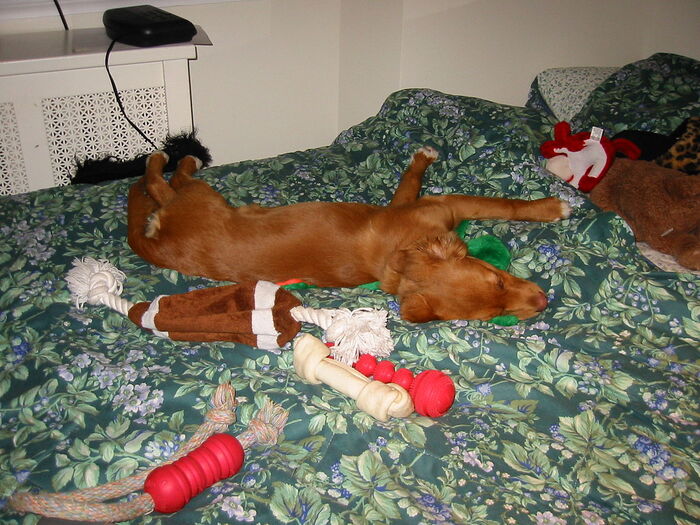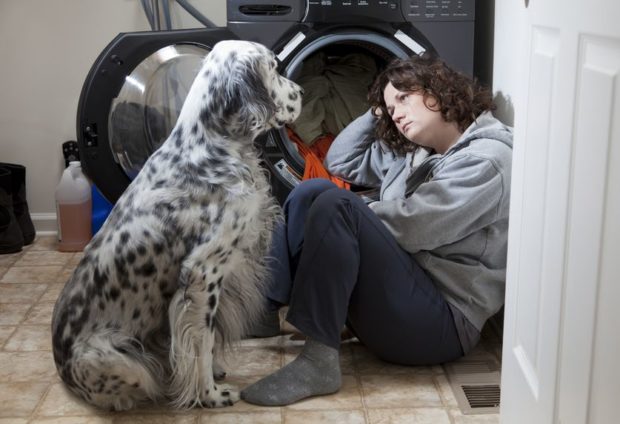
Any health conditions that our beloved paw friends deal with, drastically increase the stress levels in their owners. Thoughtful and responsible owners take their pets to regular veterinarian checks, monitor them at home and while on walks, and learn to recognize any behavioral changes that may be a sign of an underlying issue. The ability to make a difference between an illness and a behavioral issue is essential for the proper raising of a healthy and happy dog.
You may have paid attention to how your dog looks while he/she is sleeping. Dogs often move their legs like they are running or chasing an animal. Besides their trembling movements, they are likely to use vocalizations that resemble whining and whimpering. Your doggy is likely to have a dream, as dreaming is a part of the sleep that occurs not only in humans but in dogs as well. Sometimes the convulsive movements and vocalization are not a sign for processing of emotions and memories, but a sign for a seizure that your dog may experience.
In today’s article, you will find information about the possible causes for seizures, the ways you can differentiate a seizure from a dream, and the actions you can take if you notice that your dog is having a seizure.
Seizure- Definition and Types
Seizure is an abnormal and uncontrolled neuronal activity in the brain- synchronous or excessive. It can have different symptoms, i.e. uncontrolled shaking of the whole body or a part of it, changing levels of consciousness or loss of awareness. Canines are likely to experience seizures right after they wake up or while they are awake. However, if your canine experiences seizures, while they are sleeping there, may be various reasons for that.
Seizure Types
Two main seizure types can be differentiated.
1. Grand Mal Seizures
These are the so-called generalized seizures and are the most common type of seizures. They are caused by unusual electrical activity running through the brain. In the aftermath of the grand mal seizure convulsions of the full body may have occurred. Your canine may be unable to wake up or if they are already awake, they may look dizzy and be unable to response.
2. Petit Mal (Focal) Seizures
This type affects only a part of the body, i.e. legs or face, and occurs as spasms in this particular part. Dogs are not likely to experience loss of awareness during this type of seizure. However, Petit Mal Seizures can convert into Grand Mal Seizures.
Seizure Stages
- Pre-ictal: This is the stage right before a seizure occurs. Your canine may look afraid of something or too vigilant without being any reason for that. Of course, you need to know your dog and be familiar with any factors in the surrounding that may disturb them.
- Ictal: This stage represents the seizure itself and can occur as movements that repeat, loss of awareness, or a stunned look.
- Post-ictal: This is the stage that appears right after the seizure stops. During this stage your canine may look disoriented.
Causes for Seizures During Sleep
Health Condition
Epilepsy is considered the most common cause for seizures and can occur on a weekly, monthly...etc. basis. However, a seizure can also occur once and never repeats. The term “idiopathic epilepsy” is often used to show that the reason for the seizures is still unknown. They can be caused by brain tumor, blood defects, kidney or liver disease, disease of metabolism, toxins, medication...etc.
Genetic Inheritance
Some dogs can be prone to seizures due to genetic inheritance from their parents.
Brain Activity
It is assumed that dogs can experience seizures at all times, but sometimes these are provoked by a brain’s activity transition, i.e. when the dog gets scared, or is too excited, and even during the time when he/she is falling asleep or is waking up. Interruption of the neuron activity or the so-called neuron misfiring can make your dog having a seizure.
Size-related Causes
Smaller dog breeds are more prone to seizures, as their metabolism is quicker than the metabolism of larger breeds and during long sleeping time when they digest the food, seizures may occur. Furthermore, small dogs tend to be more sensitive and have a stronger emotional response to different events and even minor disturbing factors. Of course, this does not mean that small dogs will definitely experience a seizure during their lifespan, but you may want to pay a closer attention to your dog’s general health condition and behavior.
Age-Related Causes
Since we are talking about seizures during sleeping, let’s pay attention to dreams as well as to how to distinguish seizures from dreams. The ability to recognize when your dog is having a seizure and is not just sleeping may be life-saving.
Dreams
Dreams on the other hand are images, sensations and emotions that occur in the mind during different stages of sleeping and are related to experiences and memories. Through dreaming the brain processes all this information. Dreaming is considered a “device” through which the brain stores important facts and memories and eliminates non-important ones. Dogs as humans experience a short-wave sleep (SWS) stage and a rapid eye movement (REM) stage.
How to Distinguish a Seizure from a Dream?
Spasms in the legs similar to kick movements are typical for many dogs who are sleeping. When present, these movements are likely to be irregular and last up to 30 seconds.
If your dog is having a seizure and not a dream, their movements are likely to look more inflexible and severe and their limbs will be more rigid. Furthermore, the convulsions are likely to last more than 30 seconds.
If your dog is dreaming, you will be able to wake them easily.
Dogs who are experiencing a seizure can not be woken easily, and after they wake up, they are likely to look confused and disoriented.
Urinating, defecating and drooling are additional signs that will help you recognize a seizure.

What Should You Do When You Recognize a Seizure?
If you think that your dog is experiencing a seizure, you can try waking them by dropping a heavy object or just calling them by name. If they wake up easily, they may have just dreamed and there is nothing to worry about.
If your dog had a seizure and looks dizzy, you can try to prevent them from falling and injuring. For dogs who experienced seizures lasting more than 5 minutes and thus considered epileptic, you can bring some towels and slightly moisture them. You can prevent your dog from overheating by gently taping them with the wet towels on the head, neck and stomach.
Regardless of how long the seizure episode lasted, you should call a veterinarian and arrange an appointment, as seizures may be a sign of underlying health condition.
Although you are likely to panic when noticing your dog having a seizure, the best thing you can do is put yourself together and make notes or even make a record of the seizure. Any information about the seizure may be helpful for the veterinarian when making a diagnosis.
You can also remove any objects lying around your dog, as he/she may get hurt due to the convulsive movements.
What You Should Not Do?
We would not recommend that you try helping your dog not swallow their tongue. This may be dangerous for you, as you may get bitten.
Do not touch your dog while they are sleeping, as they can bite you in this case as well. If you want to wake them, use vocalization or drop some heavy object, as mentioned above.
Do not grab your dog while they are shaking in order to limit their movements. Remember that your dog can not control their movements while experiencing a seizure, and you can get injured.
If you are afraid that your canine is near an object potentially dangerous for him/her in this situation, that can not be moved, slightly push your doggy away.
There are special medications as well as home remedies for seizure prevention and treatment. However, we highly recommend that you contact a veterinarian first and not take any actions on your own.














